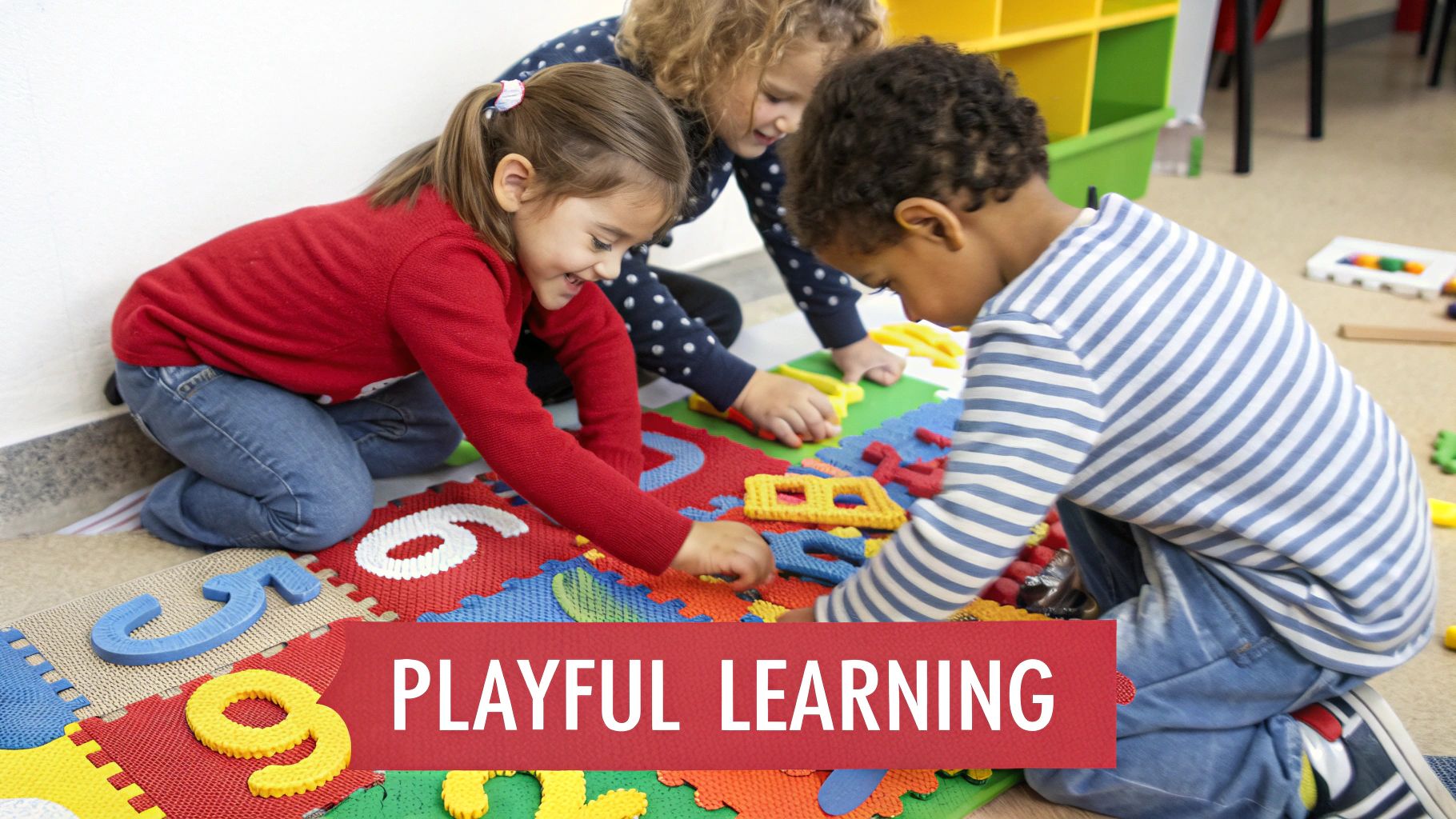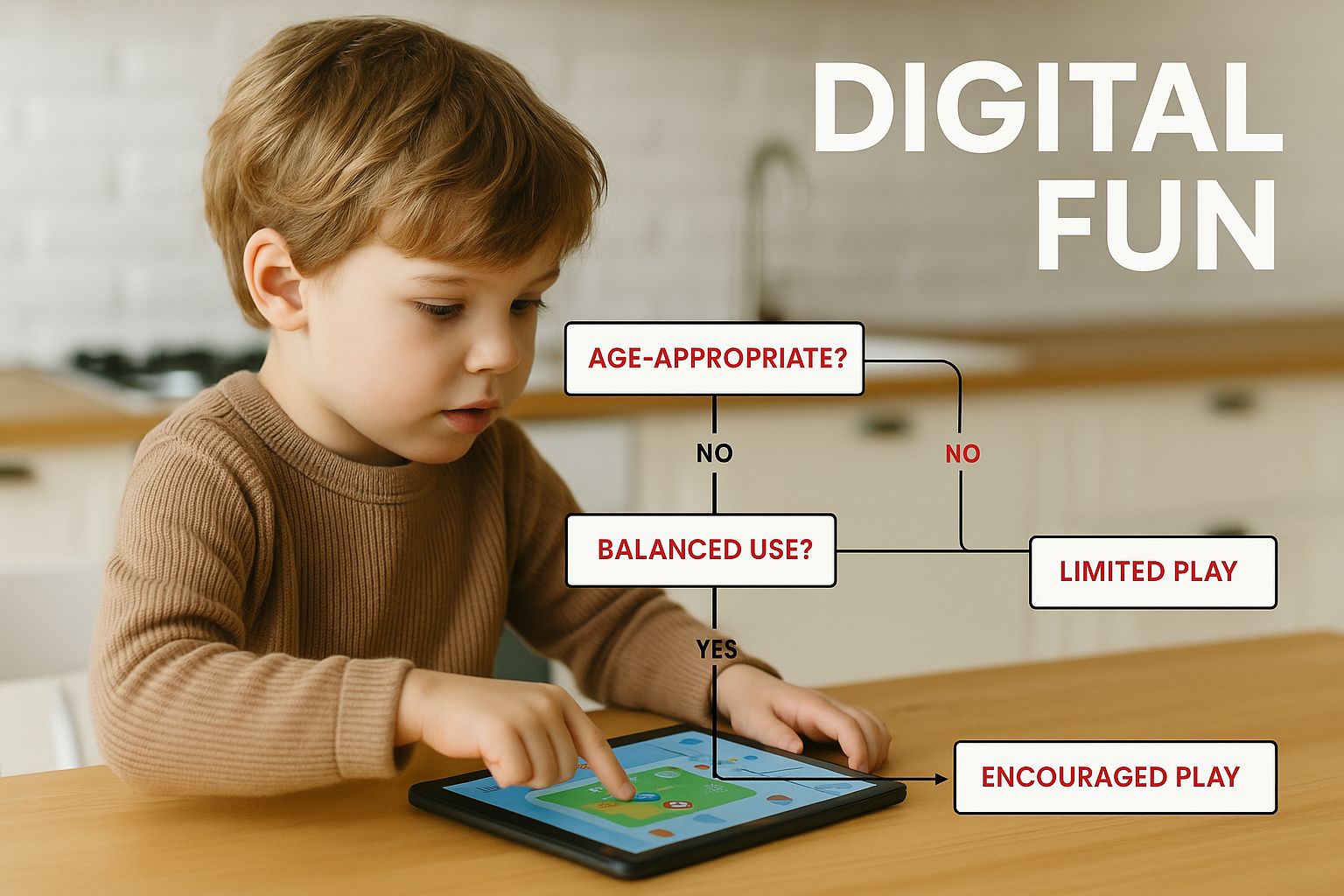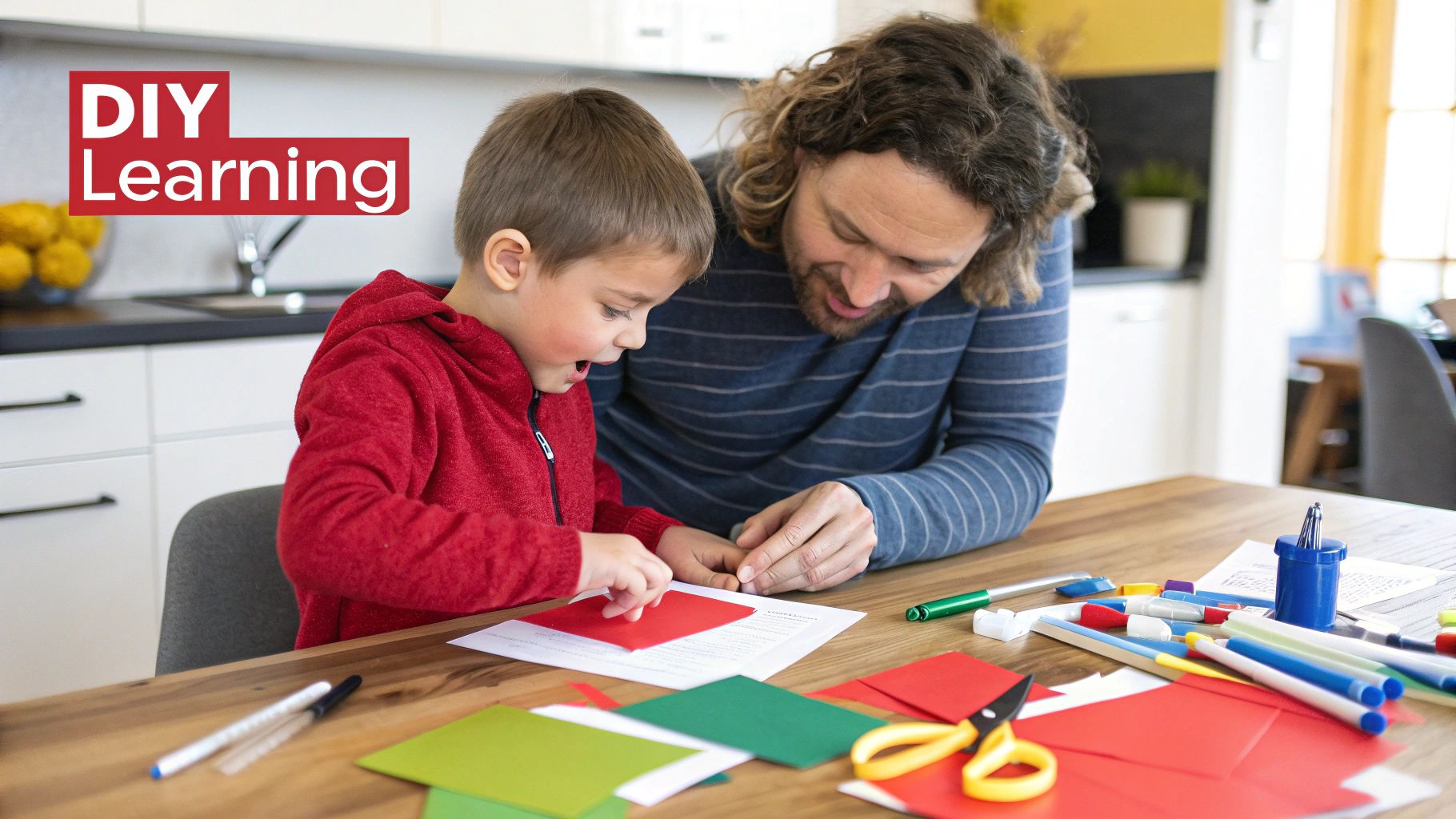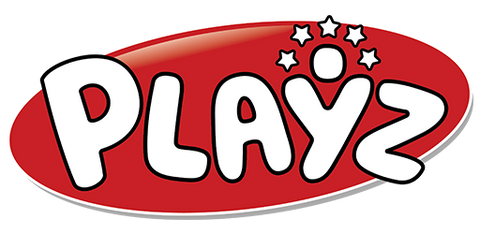
Top 10 Best Learning Games for Kids That Boost Skills and Spark Curiosity
Wading through the endless options for kids' learning games can feel overwhelming. The best ones, though, are more than just a fun way to pass the time. They cleverly mix engaging challenges with real skill-building, nurturing critical thinking, creativity, and a genuine love for learning. This guide provides actionable insights to help you choose games that truly make a difference.
Why Play is the Secret Ingredient to Effective Learning

It’s no secret that kids learn best when they're having fun. Play isn't just a way to stay busy; it's the brain's natural method for exploring, experimenting, and understanding the world. When we combine that innate drive with smartly designed educational content, something amazing happens. Screen time stops being a passive activity and becomes an active, hands-on experience.
The best learning games for kids act as a bridge, connecting a child's natural curiosity with foundational knowledge. They introduce complex ideas—like basic physics, problem-solving, or even coding—all disguised as a thrilling challenge or an engaging story. This approach removes the pressure of formal "learning," allowing kids to absorb new concepts at their own pace.
The Power of Purposeful Play and Its Impact
Purposeful play means every activity has an educational goal baked into it, even if your child just thinks they're on a grand adventure. These games are designed from the ground up to develop specific skills without ever feeling like homework.
For instance, a game that asks a child to build a virtual bridge isn't just about tapping a screen. It’s a practical lesson in basic engineering, physics, and resource management. This kind of active involvement is far more memorable and effective than simply reading about it in a book.
Parents and educators are clearly embracing this model. The global market for children's educational games hit an incredible USD 13.6 billion in 2023 and is projected to soar to USD 31.1 billion by 2033. This boom demonstrates the growing value placed on these powerful, interactive learning tools.
Key Takeaway: Play is the brain's favorite way of learning. By turning education into a game, we empower kids to become active participants in their own development, building confidence and resilience along the way.
Ultimately, the goal is to find games that spark a curiosity that lasts long after the screen is turned off. A truly great game inspires real-world questions and activities, blending digital discovery with hands-on exploration. For more ideas on this, check out our guide to the best imaginative play toys.
The Science Behind Effective Learning Games
Ever wondered what makes one educational game a hit with your kid while another becomes just a colorful distraction? The secret isn't in flashy graphics or loud noises. It's a fascinating mix of child psychology and smart game design.
The very best learning games for kids are built on a solid understanding of how a child's brain learns and what keeps them engaged. The goal is to weave learning so seamlessly into the fun that your child doesn't even realize it's happening. They're just solving a puzzle or going on an adventure, but their brain is firing on all cylinders, building new connections with every tap and swipe.
How Scaffolding Builds Knowledge Step-by-Step
One of the most powerful principles in game-based learning is scaffolding. Think about teaching a child to ride a bike. You wouldn't just give them a two-wheeler and a push. You start with training wheels. As they master balancing and pedaling, you raise the wheels, and finally, you take them off completely.
Great learning games do the exact same thing digitally:
- Introduce a Core Concept: A game might begin with a simple task, like dragging shapes to match their outlines.
- Add a Small Challenge: The next level might ask the child to rotate the shapes to fit, introducing a new layer of spatial reasoning.
- Combine Skills: Finally, the game could present a complex puzzle where the child must choose, rotate, and combine several shapes to build something new.
This steady climb in difficulty keeps kids challenged but never frustrated. Each level builds directly on what they just mastered, creating a solid foundation of understanding. This is a core part of discovery-based learning, which centers on learning through hands-on exploration. You can dive deeper into this concept in our guide to what is discovery-based learning.
The Power of Intrinsic Motivation
Why do some games feel so satisfying to play? It all comes down to intrinsic motivation—that internal drive to do something simply because it's interesting and feels good. The best learning games nail this by making the challenge itself the reward.
Key Takeaway: The most effective educational games don't just dangle external rewards like points or badges. They make the act of solving the problem so satisfying that the child is driven to keep trying, learning, and growing on their own.
This is worlds away from games that only use extrinsic motivation, like collecting virtual coins. While those can be fun for a bit, they don't create a real, lasting interest in the subject. When the reward is that "aha!" moment of finally figuring something out, the motivation comes from within. That's what builds persistence and a genuine love for learning.
Creating a Safe Space for Failure
Imagine trying to learn something new without any fear of messing up. That's the magic of a well-designed learning game. It creates a safe playground where mistakes are just part of the process.
If a child builds a tower in a physics game and it topples over, there are no real consequences. They simply try again, tweaking their design based on what they just observed. This "freedom to fail" is critical for building resilience and a growth mindset. It teaches kids that mistakes aren't dead ends; they're valuable clues on the path to success. This cycle of trial and error is where the deepest learning happens.
A Parent's Checklist for Choosing High-Quality Games
Walking through the digital aisle of kids' apps can be daunting. But once you know what to look for, you can spot the gems. Think of yourself as a detective for quality playtime. Armed with the right checklist, you can quickly differentiate between a game that genuinely builds skills and one that's just a time-filler.
This guide is designed to give you that confidence. We'll break down the essentials—from age-appropriateness to online safety—so you can evaluate any game and make a smart choice for your child.

As the image shows, the right game can turn screen time into a fun, educational experience when parents and kids engage with it thoughtfully.
Look for Clear Learning Goals
Before anything else, a good educational game needs a purpose. You should be able to ask, "What is my child actually learning here?" The best learning games for kids are upfront about their objectives, whether it's teaching phonics, introducing coding logic, or exploring scientific concepts.
This doesn't mean it has to feel like a quiz. The learning should be baked right into the gameplay. A game designed for creative problem-solving, for example, will present challenges with multiple solutions, nudging kids to think outside the box. A game that’s just about repetitive tapping for points has a much weaker educational goal.
Ensure Age-Appropriate Challenges
A game that's too easy is boring. One that's too hard is frustrating. The magic happens in that sweet spot where a challenge stretches your child’s abilities just enough to keep them engaged without feeling overwhelmed. Experts call this the Zone of Proximal Development, and it's where real learning sparks.
Look for games that:
- Adapt to Skill Level: The best apps adjust their difficulty based on your child's performance, so the challenge always feels just right.
- Offer Hints and Support: When a kid gets stuck, the game should provide helpful clues instead of letting them fail repeatedly.
- Grow with Your Child: Top-tier games offer a range of content that stays relevant as your child masters new skills.
Finding this balance is crucial for building both skills and confidence. It's the same reason hands-on STEM toys for kids are designed for specific age ranges—the tool must match the child's developmental stage to be effective.
Prioritize Safe and Ad-Free Environments
A child's digital playground should be a safe one. Unfortunately, many "free" games are packed with distracting ads, confusing in-app purchases, and links that can pull your kid out of the learning moment.
Key Takeaway: A truly educational game respects a child's focus. Constant interruptions from ads or pop-ups can shatter concentration and completely derail the learning process.
Before downloading, check a game's privacy policy and business model. A one-time purchase or a transparent subscription often provides a much safer, more focused environment. These paid models mean the developer’s goal is to create a great learning experience, not just to serve as many ads as possible.
How to Evaluate Learning Game Features: A Comparison Table
This quick-reference table breaks down what to look for—and what to avoid—when evaluating a new learning game for your child.
| Feature Category | What to Look For (Pros) | What to Avoid (Cons) |
|---|---|---|
| Learning Goals | Clearly stated objectives, skills integrated into gameplay, creative problem-solving. | Vague or non-existent goals, relies on repetitive, mindless tasks (e.g., endless tapping). |
| Challenge Level | Adapts to the child's skill, offers hints, provides a sense of accomplishment. | Too easy (boring) or too hard (frustrating), punishes failure without guidance. |
| Safety & Privacy | Ad-free, no in-app purchases, clear privacy policy, no links to external sites or social media. | Constant pop-up ads, aggressive prompts to buy items, collects personal data without consent. |
| User Interface | Intuitive navigation for kids, simple controls, instructions are easy to understand. | Confusing menus, complicated controls, requires an adult to navigate. |
Ultimately, investing a small amount in a high-quality game often provides a much better return in educational value and peace of mind. By keeping these points in mind, you can confidently pick the best learning games for kids that will genuinely support their growth and curiosity.
Matching Learning Games to Your Child's Age and Stage

Picking the best learning games for kids is like buying them new shoes. What fits a four-year-old won't work for a ten-year-old. A game that’s too advanced can be just as frustrating as one that's too simple.
The secret is matching the game’s challenges and learning goals to where your child is right now in their development. A great game meets them on their level, offering a challenge that feels exciting but achievable. When you get that alignment right, playtime becomes an incredible engine for growth.
Games for Toddlers and Preschoolers (Ages 2–5)
For our littlest learners, play is all about discovery. Games for this age group should be simple, intuitive, and focused on cause-and-effect. Think of it as a digital sandbox where they can experiment without pressure.
The goal isn't mastery; it's building fundamentals. The best games for toddlers and preschoolers focus on:
- Fine Motor Skills: Activities like dragging, dropping, and tapping strengthen small hand muscles and improve hand-eye coordination.
- Basic Concepts: This is the time to introduce colors, shapes, letters, and numbers in a playful, no-stress environment.
- Simple Puzzles: Digital shape sorters or basic matching games build early foundations for problem-solving and pattern recognition.
Real-World Example: A game where your child "feeds" a cartoon monster the correct letter or shape. The task is clear, and the reward is immediate and fun. Of course, hands-on activities are just as important, and we've got plenty of ideas in our guide to the best learning toys for preschoolers.
Games for Early Elementary Kids (Ages 6–8)
Once kids hit elementary school, their brains take a massive leap. They're ready to use logic to solve multi-step problems, follow a story, and think a few moves ahead.
Learning games for this age can become more complex and weave in a compelling narrative. Look for features like:
- Story-Driven Adventures: Wrapping math or reading challenges in an exciting quest is a surefire way to keep them hooked.
- Beginner Logic Puzzles: These might involve simple coding concepts, like arranging command blocks to help a character navigate a maze.
- Creative Tools: Digital art programs or storytelling apps let them build their own worlds, boosting creativity and self-expression.
This age group is at the heart of an explosion in educational gaming. The market for games aimed at 6 to 12-year-olds was valued at USD 25.4 billion in 2024 and is expected to skyrocket to USD 129.8 billion by 2031. This isn't just about fun; it's driven by a real understanding of how quality games can support a child’s development.
Games for Tweens (Ages 9–12)
By the tween years, kids are ready for sophisticated challenges. They can handle abstract thinking, plan long-term strategies, and understand complex systems. The best games for this age group often don't feel "educational"—they feel like full-blown strategy games that happen to teach valuable skills.
Key Takeaway: For tweens, the best learning games are those that don’t talk down to them. They offer complex, open-ended worlds where players can experiment, manage resources, and see the consequences of their decisions in real-time.
Effective games for this stage often include:
- Complex Simulations: Games that let them build a city, run a business, or manage an ecosystem are brilliant for teaching systems thinking.
- Advanced Logic and Coding: Many games introduce real programming concepts through engaging puzzle mechanics that feel more like play than work.
- Historical and Scientific Exploration: Interactive games can bring history or science to life, letting tweens explore ancient worlds or run virtual experiments.
By choosing games that grow with your child, you ensure that screen time isn't just a diversion—it's a meaningful part of their learning journey.
Bridging the Gap Between Digital and Physical Play
The future of learning isn't just on a screen. Some of the most exciting breakthroughs are happening where digital guidance meets real-world, hands-on action. This powerful blend, known as hybrid play, is a game-changer for parents and kids.
Instead of gluing children to a screen, these games use technology as a launchpad for physical exploration. A tablet becomes an interactive map that guides a real-life adventure. This approach makes learning feel tangible, creating memories that stick around far longer than a purely digital experience.
The Rise of Tangible Tech and Augmented Reality
New tools like augmented reality (AR) are leading the charge. AR can overlay digital instructions and animations onto the physical world, turning your kitchen table into a bubbling science lab. It's that "wow" factor that grabs a kid's imagination and makes tricky concepts click.
This trend is a huge reason the educational gaming sector is exploding. The game-based learning market hit USD 21.3 billion in 2024 and is on track to reach USD 80.0 billion by 2033. This growth is driven by smart integration of tech like AR that pulls screen time into the real world. You can see more details about this expanding market on imarcgroup.com.
This approach also addresses a major concern for parents: too much screen time. By making the screen a tool for a hands-on activity, these games promote a healthier balance. For more ideas, check our guide on how to limit screen time.
Actionable Insight: A Real-World Hybrid Play Example
Picture a child named Maya with a Playz chemistry kit. Instead of a dense paper booklet, she opens an app that kicks off a mission to create a "Volcano of Ooze." An animated scientist guides her through a series of mini-games.
- Step 1: The Mission Briefing: An exciting video shows the volcano erupting. Maya knows her goal and is pumped to make it happen.
- Step 2: Interactive Checklist: As Maya measures the baking soda, the app uses the tablet’s camera to recognize the action and pops up a virtual checkmark. Instant feedback!
- Step 3: The "Eureka!" Moment: When she adds the final ingredient and the fizzing starts, the app plays triumphant music and shows animated fireworks over her real-life experiment, amplifying her sense of accomplishment.
The screen isn't the main event; the hands-on experiment is. The app is a co-pilot, making chemistry feel less intimidating and turning a complex process into a fun quest. Maya is doing, observing, and learning in the physical world.
Key Takeaway: By blending digital instructions with hands-on discovery, we transform learning from a spectator sport into a full-contact activity. The child becomes the scientist, building confidence with every real-world result.
This multi-sensory learning helps lock in knowledge better than just reading text or watching a video. It's proof that the best learning games for kids don't have to stay behind a screen. They can—and should—spill out into the real world.
Your Role as a Co-Discoverer in a Digital Age
Choosing the right educational game is about more than finding a popular app. It’s about understanding what makes learning click for your child and stepping into the role of a co-discoverer alongside them. You're not just a consumer; you're the guide who can turn a simple game into a lesson that sticks.
When you get involved, you send a powerful message: learning is a cool adventure you get to share. That simple shift transforms screen time into quality time. It’s all about asking questions, celebrating small wins, and creating a home where curiosity is the most important skill of all.
Key Takeaways for Parents
Throughout this guide, we’ve laid out a roadmap for spotting learning tools that actually work. Keep that parent's checklist handy, and always look for clear goals and age-appropriate challenges. The best learning games for kids are the ones that meet them where they are and nudge them to think bigger.
At the end of the day, the goal is to raise a lifelong learner. When you become an active partner in that process, you give your child the incredible gift of seeing every challenge not as a roadblock, but as a fascinating puzzle just waiting to be solved.
The real magic happens when you find the sweet spot between digital fun and real-world discovery. The best experiences are those that bridge that gap, using a screen to kickstart hands-on exploration. That’s where deep, meaningful learning takes root.
Ready to see this in action? Playz science kits master this blend of gamified instructions and hands-on experiments, turning your kitchen table into a buzzing laboratory.
Frequently Asked Questions (FAQ)
Diving into the world of educational apps can feel overwhelming. It’s normal to have questions about screen time, cost, and whether your kid is actually learning anything. Let's clear up some of the most common concerns.
How Much Screen Time Is Too Much?
The conversation is shifting from the quantity of screen time to its quality. An hour spent solving logic puzzles is very different from an hour spent passively watching cartoons. The American Academy of Pediatrics encourages parents to play alongside younger kids, turning screen time into a shared bonding activity. For older kids, it all comes down to balance. Think of high-quality learning games as "tool time" for their brains—a productive activity that needs to fit alongside physical play, creative hobbies, and social time.
Are Free Games Just as Good as Paid Ones?
While some great free learning games exist, "free" often comes with a hidden cost: constant ads or pop-ups asking you to buy something. These interruptions break a child's focus and derail the learning process.
Actionable Insight: A game's business model reveals its priorities. If an app is constantly trying to sell your child something, its main goal is likely revenue, not education.
Paid or subscription-based games from trusted developers usually offer a cleaner, more focused experience. Removing ads and sales pitches creates a space where learning can happen without distractions.
How Can I Tell if My Child Is Really Learning?
The best proof often shows up when the screen is off. Pay attention to the conversations after they play. Are they asking questions about planets after a space game? Are they trying to build a sturdier block tower using ideas from a physics puzzle? The best learning games for kids spark curiosity that lasts. A simple way to check is to ask them what they're doing. If they can excitedly explain the challenge they just beat, you can be confident that real learning is happening.
Ready to connect digital fun with real-world discovery? Playz makes award-winning science kits that transform tricky subjects into amazing, hands-on adventures. Check out our collection and find the perfect kit to spark your child's curiosity at https://www.playzusa.com.
